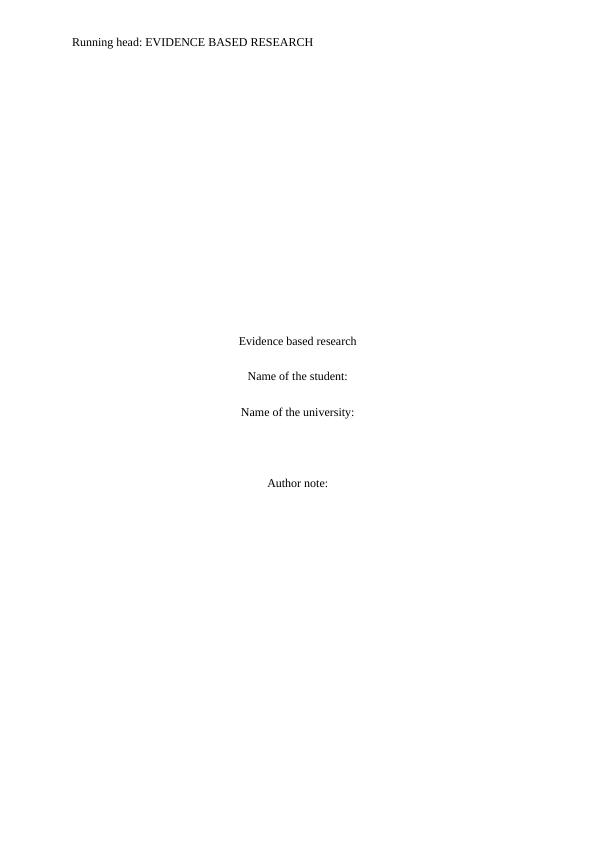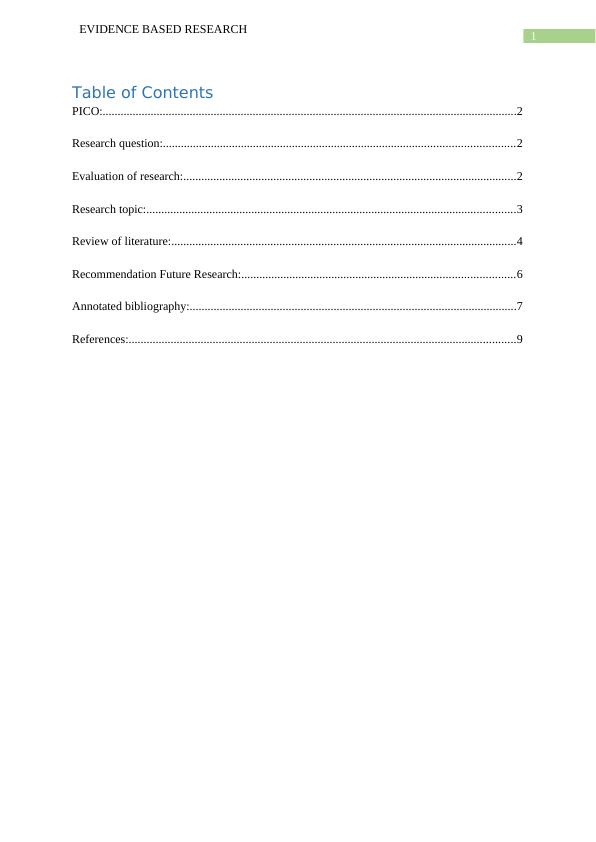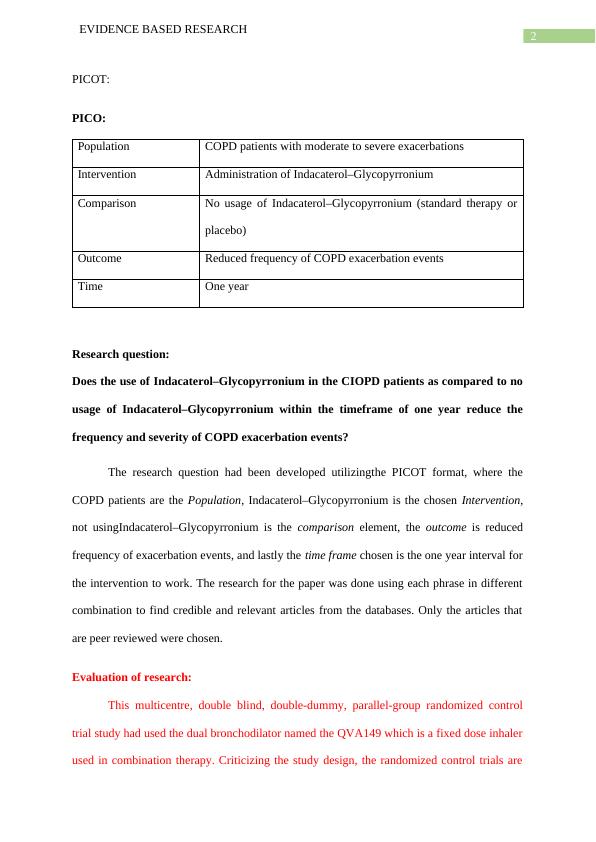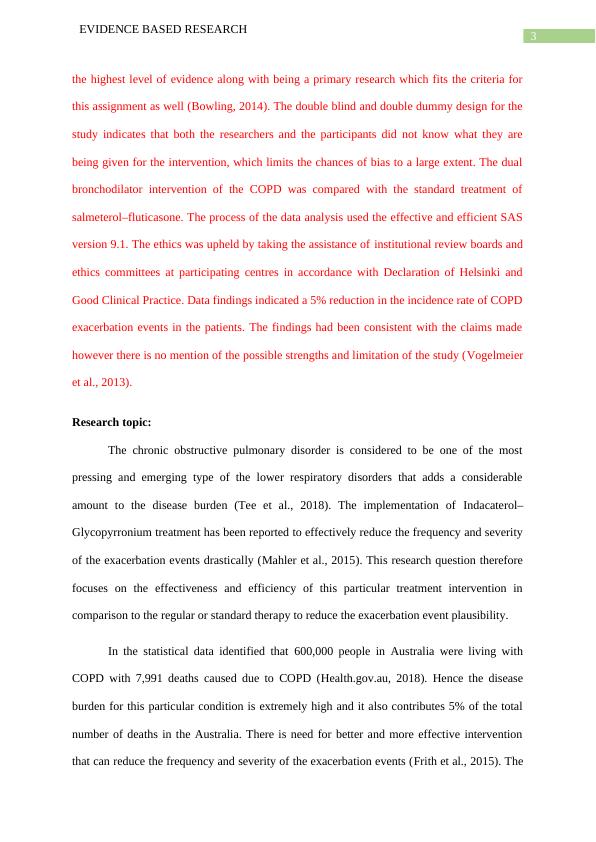Evidence Based Research on Indacaterol–Glycopyrronium for COPD Patients
Added on 2023-06-05
13 Pages3022 Words214 Views
Running head: EVIDENCE BASED RESEARCH
Evidence based research
Name of the student:
Name of the university:
Author note:
Evidence based research
Name of the student:
Name of the university:
Author note:

1
EVIDENCE BASED RESEARCH
Table of Contents
PICO:..........................................................................................................................................2
Research question:.....................................................................................................................2
Evaluation of research:...............................................................................................................2
Research topic:...........................................................................................................................3
Review of literature:...................................................................................................................4
Recommendation Future Research:...........................................................................................6
Annotated bibliography:.............................................................................................................7
References:.................................................................................................................................9
EVIDENCE BASED RESEARCH
Table of Contents
PICO:..........................................................................................................................................2
Research question:.....................................................................................................................2
Evaluation of research:...............................................................................................................2
Research topic:...........................................................................................................................3
Review of literature:...................................................................................................................4
Recommendation Future Research:...........................................................................................6
Annotated bibliography:.............................................................................................................7
References:.................................................................................................................................9

2
EVIDENCE BASED RESEARCH
PICOT:
PICO:
Population COPD patients with moderate to severe exacerbations
Intervention Administration of Indacaterol–Glycopyrronium
Comparison No usage of Indacaterol–Glycopyrronium (standard therapy or
placebo)
Outcome Reduced frequency of COPD exacerbation events
Time One year
Research question:
Does the use of Indacaterol–Glycopyrronium in the CIOPD patients as compared to no
usage of Indacaterol–Glycopyrronium within the timeframe of one year reduce the
frequency and severity of COPD exacerbation events?
The research question had been developed utilizingthe PICOT format, where the
COPD patients are the Population, Indacaterol–Glycopyrronium is the chosen Intervention,
not usingIndacaterol–Glycopyrronium is the comparison element, the outcome is reduced
frequency of exacerbation events, and lastly the time frame chosen is the one year interval for
the intervention to work. The research for the paper was done using each phrase in different
combination to find credible and relevant articles from the databases. Only the articles that
are peer reviewed were chosen.
Evaluation of research:
This multicentre, double blind, double-dummy, parallel-group randomized control
trial study had used the dual bronchodilator named the QVA149 which is a fixed dose inhaler
used in combination therapy. Criticizing the study design, the randomized control trials are
EVIDENCE BASED RESEARCH
PICOT:
PICO:
Population COPD patients with moderate to severe exacerbations
Intervention Administration of Indacaterol–Glycopyrronium
Comparison No usage of Indacaterol–Glycopyrronium (standard therapy or
placebo)
Outcome Reduced frequency of COPD exacerbation events
Time One year
Research question:
Does the use of Indacaterol–Glycopyrronium in the CIOPD patients as compared to no
usage of Indacaterol–Glycopyrronium within the timeframe of one year reduce the
frequency and severity of COPD exacerbation events?
The research question had been developed utilizingthe PICOT format, where the
COPD patients are the Population, Indacaterol–Glycopyrronium is the chosen Intervention,
not usingIndacaterol–Glycopyrronium is the comparison element, the outcome is reduced
frequency of exacerbation events, and lastly the time frame chosen is the one year interval for
the intervention to work. The research for the paper was done using each phrase in different
combination to find credible and relevant articles from the databases. Only the articles that
are peer reviewed were chosen.
Evaluation of research:
This multicentre, double blind, double-dummy, parallel-group randomized control
trial study had used the dual bronchodilator named the QVA149 which is a fixed dose inhaler
used in combination therapy. Criticizing the study design, the randomized control trials are

3
EVIDENCE BASED RESEARCH
the highest level of evidence along with being a primary research which fits the criteria for
this assignment as well (Bowling, 2014). The double blind and double dummy design for the
study indicates that both the researchers and the participants did not know what they are
being given for the intervention, which limits the chances of bias to a large extent. The dual
bronchodilator intervention of the COPD was compared with the standard treatment of
salmeterol–fluticasone. The process of the data analysis used the effective and efficient SAS
version 9.1. The ethics was upheld by taking the assistance of institutional review boards and
ethics committees at participating centres in accordance with Declaration of Helsinki and
Good Clinical Practice. Data findings indicated a 5% reduction in the incidence rate of COPD
exacerbation events in the patients. The findings had been consistent with the claims made
however there is no mention of the possible strengths and limitation of the study (Vogelmeier
et al., 2013).
Research topic:
The chronic obstructive pulmonary disorder is considered to be one of the most
pressing and emerging type of the lower respiratory disorders that adds a considerable
amount to the disease burden (Tee et al., 2018). The implementation of Indacaterol–
Glycopyrronium treatment has been reported to effectively reduce the frequency and severity
of the exacerbation events drastically (Mahler et al., 2015). This research question therefore
focuses on the effectiveness and efficiency of this particular treatment intervention in
comparison to the regular or standard therapy to reduce the exacerbation event plausibility.
In the statistical data identified that 600,000 people in Australia were living with
COPD with 7,991 deaths caused due to COPD (Health.gov.au, 2018). Hence the disease
burden for this particular condition is extremely high and it also contributes 5% of the total
number of deaths in the Australia. There is need for better and more effective intervention
that can reduce the frequency and severity of the exacerbation events (Frith et al., 2015). The
EVIDENCE BASED RESEARCH
the highest level of evidence along with being a primary research which fits the criteria for
this assignment as well (Bowling, 2014). The double blind and double dummy design for the
study indicates that both the researchers and the participants did not know what they are
being given for the intervention, which limits the chances of bias to a large extent. The dual
bronchodilator intervention of the COPD was compared with the standard treatment of
salmeterol–fluticasone. The process of the data analysis used the effective and efficient SAS
version 9.1. The ethics was upheld by taking the assistance of institutional review boards and
ethics committees at participating centres in accordance with Declaration of Helsinki and
Good Clinical Practice. Data findings indicated a 5% reduction in the incidence rate of COPD
exacerbation events in the patients. The findings had been consistent with the claims made
however there is no mention of the possible strengths and limitation of the study (Vogelmeier
et al., 2013).
Research topic:
The chronic obstructive pulmonary disorder is considered to be one of the most
pressing and emerging type of the lower respiratory disorders that adds a considerable
amount to the disease burden (Tee et al., 2018). The implementation of Indacaterol–
Glycopyrronium treatment has been reported to effectively reduce the frequency and severity
of the exacerbation events drastically (Mahler et al., 2015). This research question therefore
focuses on the effectiveness and efficiency of this particular treatment intervention in
comparison to the regular or standard therapy to reduce the exacerbation event plausibility.
In the statistical data identified that 600,000 people in Australia were living with
COPD with 7,991 deaths caused due to COPD (Health.gov.au, 2018). Hence the disease
burden for this particular condition is extremely high and it also contributes 5% of the total
number of deaths in the Australia. There is need for better and more effective intervention
that can reduce the frequency and severity of the exacerbation events (Frith et al., 2015). The

End of preview
Want to access all the pages? Upload your documents or become a member.
Related Documents
Evolocumab Therapy for Cardiovascular Diseases: A Literature Reviewlg...
|13
|2881
|331
Evidence Based Nursing Research on Home-Based Health Care Involvement in COPDlg...
|6
|1607
|264
Music Therapy for Depression: A Systematic Reviewlg...
|13
|2833
|182
Reflective Journal on Capstone Proposallg...
|4
|784
|414
PICOT Statement and Literature Search for Evidence-Based Practice in Nursinglg...
|14
|3161
|193
Critique of the Articlelg...
|8
|2239
|100